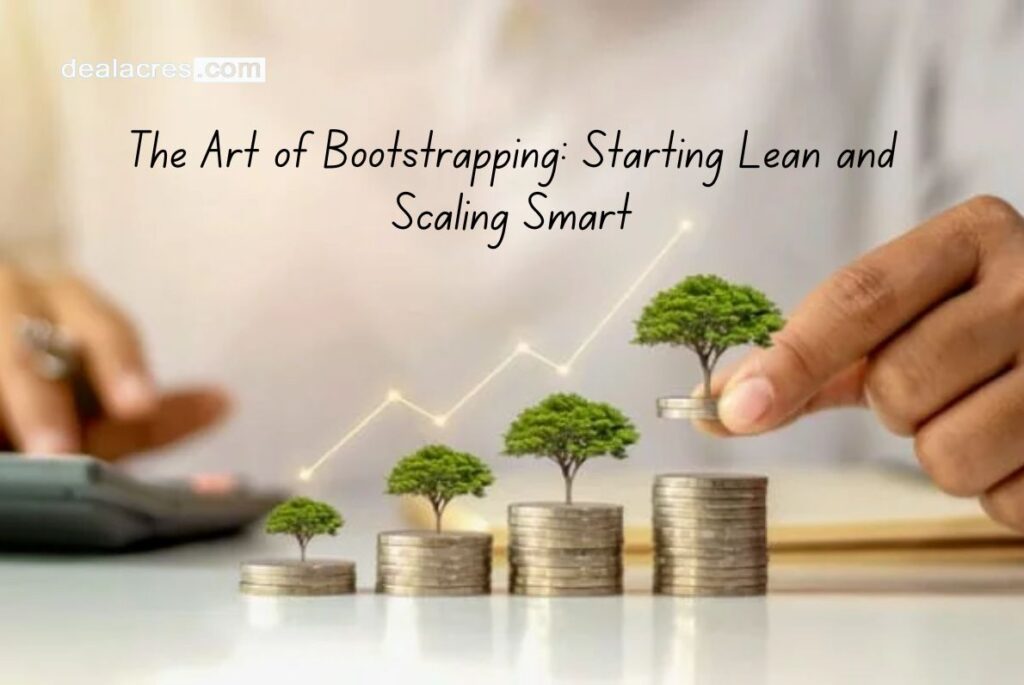Introduction:
In the world of entrepreneurship, there’s a term called “bootstrapping.” It’s not about pulling yourself up by your shoelaces, but rather about starting a business with minimal resources and building it up gradually. Bootstrapping is like building a house with whatever materials you have lying around – it requires creativity, resilience, and a willingness to do things differently. In this article, we’ll delve into the art of bootstrapping, exploring how to start lean and scale smart.

What is Bootstrapping?
Bootstrapping is a method of starting a business without relying on external funding or investment. Instead of seeking out investors or loans, bootstrappers use their resources – whether it’s personal savings, credit cards, or revenue generated from early sales – to fund their ventures. This approach allows entrepreneurs to maintain full control over their businesses and retain ownership without having to give up equity to investors.
The Benefits of Bootstrapping:
- Independence: Bootstrapping gives entrepreneurs the freedom to pursue their vision without outside interference. Since they’re not beholden to investors or lenders, bootstrappers can make decisions based on what’s best for their business, rather than what’s most profitable for others.
- Resourcefulness: Bootstrappers learn to do more with less. With limited funds at their disposal, they become adept at finding creative solutions to challenges and maximizing the impact of every dollar spent.
- Control: By funding their ventures, bootstrappers retain complete control over their businesses. They don’t have to answer to shareholders or adhere to outside agendas, allowing them to stay true to their vision and values.
- Focus on Revenue: Bootstrapped businesses are often laser-focused on generating revenue from day one. Without the cushion of investor funding, entrepreneurs must prioritize activities that drive sales and profitability, leading to a leaner and more sustainable business model.
- Resilience: Bootstrappers face numerous obstacles on their entrepreneurial journey, from cash flow crunches to unexpected setbacks. However, by learning to navigate these challenges with limited resources, they develop a resilience that serves them well in the long run.

How to Bootstrap Your Business:
- Start Small: Instead of trying to build the next billion-dollar unicorn overnight, focus on creating a minimum viable product (MVP) that addresses a specific need or pain point. Keep your initial costs low by using off-the-shelf tools and leveraging free resources wherever possible.
- Validate Your Idea: Before investing significant time and money into your venture, validate your business idea to ensure there’s a market demand for your product or service. Conduct market research, gather feedback from potential customers, and iterate based on their input.
- Keep Overheads Low: One of the key principles of bootstrapping is to minimize overhead costs. Look for ways to operate leanly, whether it’s by working from home, outsourcing non-core functions, or negotiating favorable terms with suppliers.
- Embrace Frugality: Bootstrapping requires a mindset shift towards frugality. Instead of splurging on fancy office space or expensive marketing campaigns, focus on cost-effective strategies that deliver maximum results. Be judicious with your spending and prioritize investments that offer a high return on investment.
- Hustle Hard: Bootstrapping is not for the faint of heart. It requires hustle, grit, and a willingness to roll up your sleeves and do whatever it takes to make your business succeed. Be prepared to wear multiple hats, work long hours, and hustle for every sale.
- Reinvest Profits: As your business starts to generate revenue, resist the temptation to splurge on luxuries. Instead, reinvest your profits back into the business to fuel growth and expansion. Reinvesting early profits allows you to scale your business organically without taking on debt or diluting equity.

Scaling Smart:
While bootstrapping can help you get your business off the ground, eventually, you may reach a point where you need to scale up to meet growing demand. Scaling smart means expanding your business sustainably and strategically, without sacrificing the principles of bootstrapping. Here are some tips for scaling smart:
- Focus on Profitability: As you scale your business, prioritize activities that contribute to profitability. Avoid chasing vanity metrics or pursuing growth at any cost. Instead, focus on building a solid foundation of recurring revenue streams that will sustain your business over the long term.
- Automate and Delegate: Look for opportunities to automate repetitive tasks and delegate non-core functions to free up your time and resources. Investing in systems and processes that streamline your operations will allow you to scale more efficiently and focus on strategic initiatives.
- Foster a Culture of Innovation: As your business grows, continue to foster a culture of innovation and experimentation. Encourage your team to think creatively, take calculated risks, and challenge the status quo. Innovation is the lifeblood of any successful business, and fostering a culture that embraces it will fuel continued growth and success.
- Stay Lean and Agile: Just because your business is growing doesn’t mean you should abandon the principles of bootstrapping. Stay lean and agile, remaining nimble enough to pivot in response to changing market conditions. Resist the urge to overextend yourself or commit to long-term obligations that could hamper your flexibility.
Conclusion:
Bootstrapping is not just a funding strategy – it’s a mindset. It’s about doing more with less, staying scrappy and resourceful, and building a business that’s sustainable for the long haul. By starting lean and scaling smart, entrepreneurs can create resilient businesses that thrive in any economic climate. So if you’re thinking about starting a business, don’t let a lack of funding hold you back. Embrace the art of bootstrapping and embark on the journey of entrepreneurship with confidence and determination.




